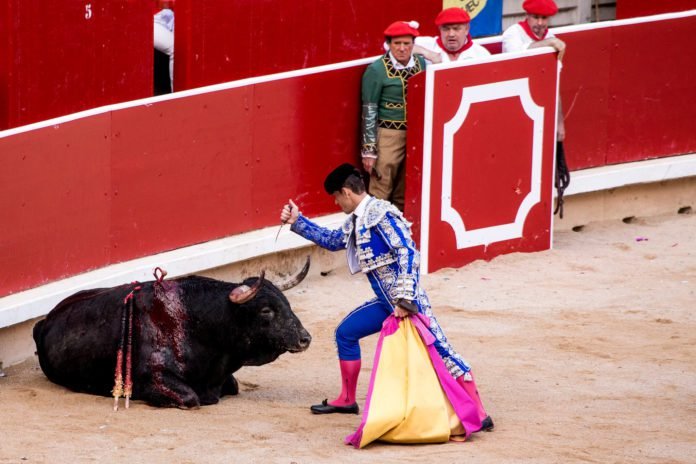Honour. Valour. Art.
The bull, the protagonist of what the government has reckoned Spain’s cultural heritage; thrashes wildly in the centre of the arena, blood oozing from its neck and back, splashing its bullies as they continuously stab at him with long lances, atop the safety of charging horses. His fur matted and his senses weakened under the stress of the jeering crowd. The hero of the day, a matador, in a sequined suit, waltzes in; brandishing a red cape, disguising a sword to finish the fight.
Before the bull stepped into the ring, his opponents shaved off part of his horns to keep him off balance, drugged him, or blinded him with petroleum jelly. Further skewing the so-called fight in the matador’s favour. The bull, dizzied by blood loss and thrown by his impairments, is baited towards the matador’s muleta as the hero strikes him, aiming to sever the aorta or else the spinal cord.
For the deserving audience, the matador, skilled enough to know where to aim, stretches out the bull’s miserable death sentence. Once he finally hits his target, the bull lies paralyzed at his feet. Defenceless, the bull’s ears and tail are cut off as a trophy.
The crowd goes wild, erupts in applause. And the bull is dead.
A Historical Seesaw
Spain’s most iconic pastime, though in decline today, is still celebrated across the country as a show of bravery. Besides bullfighting, the bull is also subjected to multiple fiestas throughout the year, such as the San Fermín running of the bull in Pamplona, Spain. Eight days, full of dancing, drinking, and feasting. As for its main attraction, four to six-year-old bulls are released into cobblestoned streets, goaded by a pack of runners and their supporters. The beasts slip through the streets and crash into walls, breaking their legs and damaging their horns. The run ends at an arena, where the bulls are paraded in a losing fight without any prior medical attention.
The bull was once a revered religious symbol but turned into a play-thing in the Middle Ages; when nobles began to celebrate marriages and authority with its death. The new tradition was met with criticism: in 1567, Pope Pius V issued a papal bull prohibiting the fighting of all animals, but was overturned a mere eight years later by his successor Pope Gregory XIII. The 18th and 19th centuries saw further debates over the bloodsport, none of which were successful. Its commercialization led to its peak popularity towards the end of the last century. Over the past two decades, younger generations of Spaniards have joined animal rights movements calling for its abolition.
The End of an “Archaic” Practice?
Though bullfighting persists throughout Spain, France, and Latin American countries such as Argentina and parts of Mexico, public interest has severely diminished amongst newer generations. In Spain, the bullfighting industry is now mostly maintained by tourism, and EU subsidies to breeders of fighting bulls under the Agricultural Common Policy.
A survey conducted by the BBVA Foundation in January 2022, found that only 23% of citizens supported the use of animals in bullfighting and other similar traditional activities. Likewise, only 6-8% of the native population attended bullfights.
While bullfighting is still legal, various autonomous communities have attempted to regulate the sport. For example, the Canary Islands passed a law against animal abuse during bullfights to mitigate the inhumane aspects of the spectacle. In 2010, Catolonía banned bullfighting outright, through a citizen’s initiative of 180,000 signatories. However, legislation was not passed to ban the running of the bulls festivities that are still celebrated throughout the region. Many criticised this selectivity as a political move inching autonomous communities towards independence.
In opposition, a conservative bill was passed by the Popular Party and Vox, both of which claimed parliamentary majority at the time. Law 18/2013, placed bullfighting and other such festivities on a pedestal of Spanish cultural heritage. It states that bullfighting “deserves to be preserved as a treasure of our country.” Though it recognizes public divide regarding the subject, it maintains that whoever enjoys the show should have freedom to choose whether to partake-in, and maintain the tradition. For this reason, in 2016, the Spanish constitutional court ruled eight-to-three declaring the Catálan ban unconstitutional and void.
Left Out of the Conversation: New Laws
Asserting the blood sport as a cultural heritage, Spain ultimately hindered the progression of animal protection laws for bulls. Despite the delay, multiple regions have since regulated the sport, to follow modern animal rights standards, as well as imagine a safer execution for the participants.
In 2017, the Balearic Islands’ parliament passed a bill banning the bull’s death at the end of bullfights, and its physical and psychological damage during the event. The 20-30 minute fights were also cut by half.
In Valencia, where Bous al Carrer, a bull-running festival, is held, more than 300 people were injured while participating in the fiesta and seven killed. While urging respect for the bulls, the government added new regulations; including prohibiting participation of the physically or mentally unfit, minors under 16, drunkards, and individuals on drugs.
However, Spanish animal rights party, PACMA, insisted that mitigation consisted only of a full ban of the fiestas. They stated, “these events are based on extreme cruelty and violence and, as such, are an authentic torture for animals and a huge danger to all people. This is about archaic traditions that foment violence and poison society.”
A complete ban after the 2013 bill is easier said than done, as, beyond regional regulation, no national law protects the bull. The Animal Protection Index (API), compares nations through criteria such as legislation on animal exploitation, scientific research, and recognition of sentience for wild and captive animals. API gives Spain “C”, using an A to F ranking scale, F being the lowest.
Despite being a member of the EU, which recognizes animals as sentient beings and urges full regard to animal welfare, Spain has been chastised on multiple occasions for animal welfare breaches – such as raising chickens in battery cages.
Until 2022, the country did not formally recognize animal sentience. Even then, a caveat in Article 13 of the TFEU allows religious and cultural traditions to disregard animal welfare policies. Thus, bulls were left out of the Animal Protection and Welfare Law that only frowns upon the seizure, abandonment, mistreatment, and separation of companion animals from its owner; with little mention of the wellbeing of rural animals. Before Law 18/2013, Spain’s animal protection laws even included special articles excluding the bull. For instance, Law 32/2007 sets provisions for the conditions for animal farming, transport, and slaughter, but states that it doesn’t apply to wild games and bullfighting events.
A canyon divides the supporters of the age-old Spanish tradition and future-forward animal movements taking hold of the country. Though it has yet to witness a stronger regard for the fighting bull on a national level, Spain’s modern protection laws for other animals carries hope that the status quo could be broken soon.








